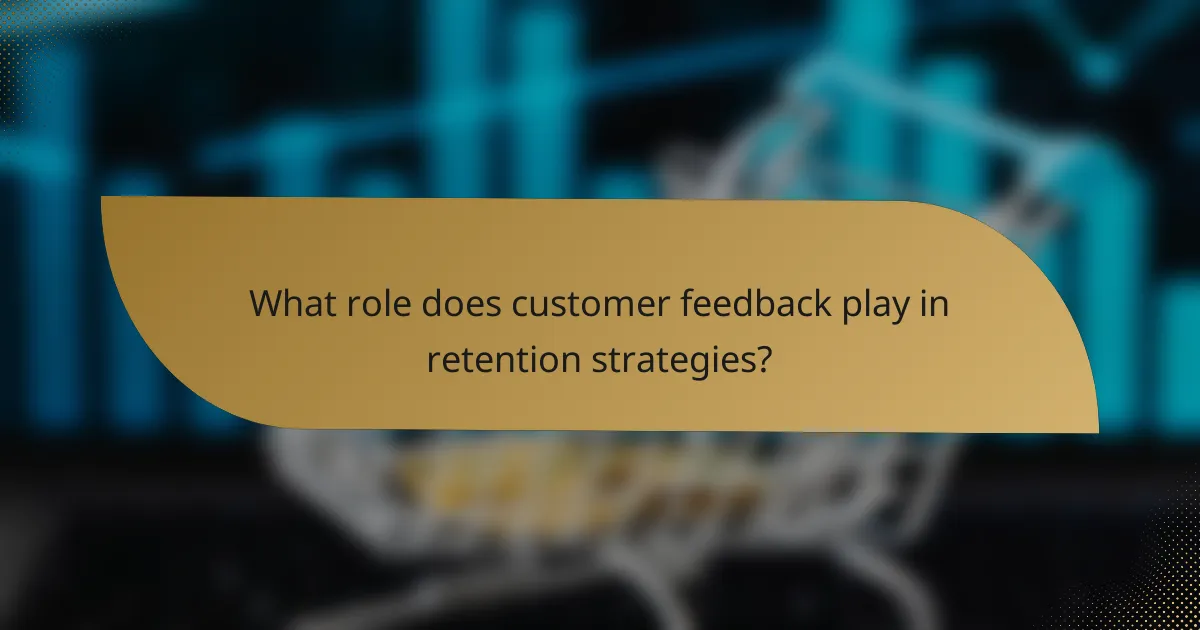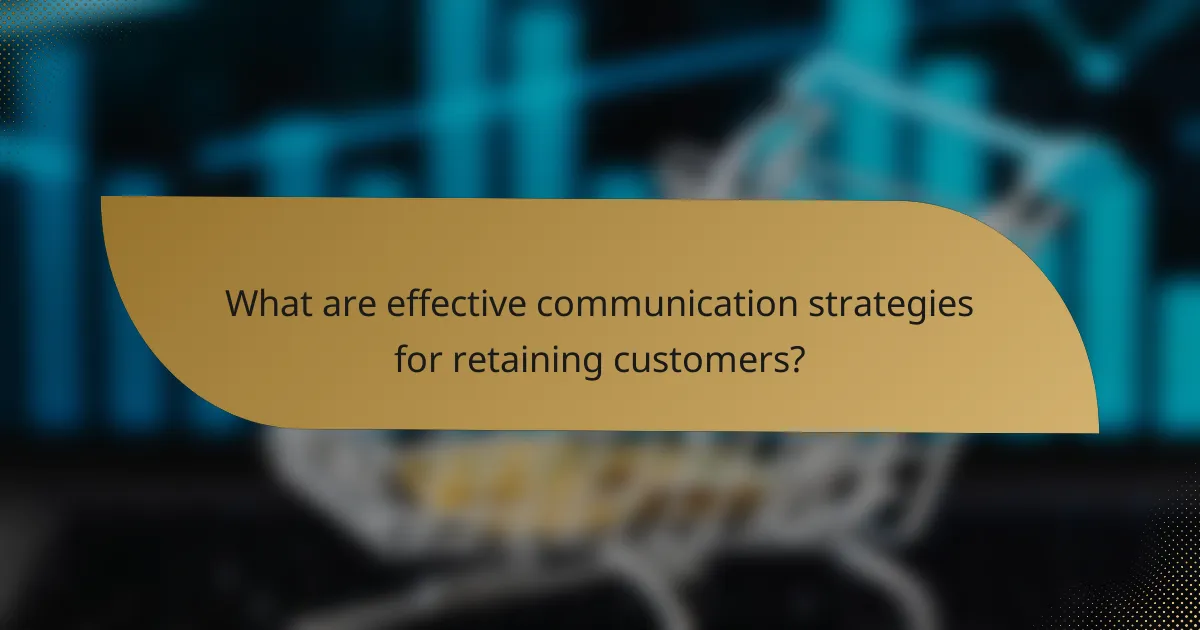In the highly competitive landscape of resale markets, e-commerce businesses must prioritize customer retention to thrive. By implementing loyalty initiatives, delivering exceptional service, and creating personalized experiences, companies can foster trust and encourage repeat purchases. Additionally, leveraging customer feedback and data analytics allows businesses to refine their strategies, ensuring they meet evolving customer needs and enhance overall satisfaction.

How can e-commerce businesses improve customer retention in resale markets?
E-commerce businesses can enhance customer retention in competitive resale markets by focusing on loyalty initiatives, superior service, and personalized experiences. These strategies help build trust and encourage repeat purchases, crucial for maintaining a loyal customer base.
Implement loyalty programs
Loyalty programs reward customers for their repeat business, fostering a sense of belonging and appreciation. Consider offering points for purchases that can be redeemed for discounts or exclusive products, which can significantly increase customer engagement.
To be effective, loyalty programs should be easy to understand and accessible. A tiered system can motivate customers to reach higher levels for better rewards, enhancing their overall shopping experience.
Enhance customer service
Exceptional customer service is vital for retaining customers in resale markets. Quick response times and knowledgeable support staff can resolve issues efficiently, making customers feel valued and understood.
Utilizing multiple channels for customer support, such as live chat, email, and phone, can cater to different preferences. Training staff to handle inquiries with empathy and professionalism can lead to higher satisfaction rates.
Utilize personalized marketing
Personalized marketing tailors messages and offers to individual customer preferences, increasing the likelihood of repeat purchases. Use data analytics to understand customer behavior and segment your audience for targeted campaigns.
For example, sending personalized emails with product recommendations based on past purchases can enhance engagement. Consider using dynamic content on your website to showcase items that align with a customer’s browsing history.
Offer exclusive deals
Exclusive deals create a sense of urgency and special treatment, encouraging customers to make purchases. Limited-time offers or member-only discounts can drive sales and enhance customer loyalty.
To maximize impact, clearly communicate the exclusivity of these deals through various channels, such as newsletters or social media. This strategy not only boosts sales but also reinforces the value of being a loyal customer.
Streamline return processes
A hassle-free return process can significantly improve customer retention. Simplifying returns builds trust and encourages customers to make purchases without fear of being stuck with unwanted items.
Consider offering free returns and providing clear instructions on how to return items. A straightforward return policy can enhance customer satisfaction and lead to repeat business, as customers are more likely to shop again if they know returns are easy.

What role does customer feedback play in retention strategies?
Customer feedback is essential for developing effective retention strategies as it provides insights into customer preferences and experiences. By actively listening to customers, businesses can identify areas for improvement and tailor their offerings to meet customer needs, ultimately enhancing loyalty and satisfaction.
Identifying pain points
Understanding customer pain points is crucial for retention. These are the specific issues or challenges that customers face when using a product or service. Regularly collecting feedback through surveys, reviews, and direct communication can help businesses pinpoint these pain points.
Once identified, companies should prioritize addressing these issues. For instance, if customers frequently mention long wait times for support, implementing a more efficient customer service system can significantly enhance their experience and reduce churn.
Improving product offerings
Customer feedback directly informs product development and enhancements. By analyzing feedback, businesses can identify which features are valued and which are lacking. This allows for targeted improvements that align with customer expectations.
For example, if a significant number of customers express a desire for additional color options in a product, introducing these variations can lead to increased satisfaction and sales. Regularly updating offerings based on feedback keeps the product line fresh and relevant.
Building trust and loyalty
Building trust through transparency and responsiveness is vital for customer retention. When customers see that their feedback leads to tangible changes, they are more likely to feel valued and remain loyal. Acknowledging feedback publicly and sharing how it has influenced decisions can strengthen this bond.
Additionally, implementing loyalty programs that reward customers for their feedback can further enhance trust. For instance, offering discounts or exclusive access to new products in exchange for feedback fosters a sense of partnership between the business and its customers.

How can data analytics enhance customer retention?
Data analytics can significantly improve customer retention by providing insights into customer behavior, preferences, and potential churn. By leveraging data, businesses can tailor their strategies to meet customer needs, ultimately fostering loyalty and increasing lifetime value.
Tracking customer behavior
Tracking customer behavior involves collecting data on how customers interact with products and services. This can include monitoring purchase history, website navigation, and engagement with marketing materials. By analyzing this data, businesses can identify trends and patterns that indicate customer preferences and pain points.
For example, if analytics reveal that customers frequently abandon their shopping carts, businesses can implement targeted follow-up emails or special offers to encourage completion of those purchases. Regularly reviewing behavior data helps in adjusting marketing strategies to better align with customer expectations.
Segmenting customer profiles
Segmenting customer profiles allows businesses to categorize customers based on shared characteristics, such as demographics, purchasing behavior, and engagement levels. This segmentation enables more personalized marketing efforts, which can enhance customer retention by making customers feel understood and valued.
For instance, a retailer might identify a segment of high-value customers who frequently purchase premium products. By offering exclusive promotions or loyalty rewards tailored to this group, the retailer can strengthen relationships and encourage repeat purchases. Effective segmentation can lead to more efficient resource allocation and improved marketing ROI.
Predicting churn rates
Predicting churn rates involves using data analytics to identify customers who are likely to stop engaging with a business. By analyzing factors such as purchase frequency, customer feedback, and service interactions, businesses can develop models to forecast churn and take proactive measures to retain at-risk customers.
For example, if data indicates that customers who have not made a purchase in several months are at a higher risk of churning, a business can reach out with personalized re-engagement campaigns or special offers. Implementing churn prediction models can significantly reduce customer loss and improve overall retention strategies.

What are effective communication strategies for retaining customers?
Effective communication strategies for retaining customers focus on building relationships and ensuring customer satisfaction. By utilizing various channels and personalized approaches, businesses can foster loyalty and encourage repeat purchases.
Email marketing campaigns
Email marketing campaigns are a powerful tool for customer retention. By sending targeted messages that offer value, such as exclusive discounts or personalized recommendations, businesses can keep their brand top-of-mind for customers.
To maximize effectiveness, segment your email list based on customer behavior and preferences. This allows for tailored content that resonates with specific groups, increasing engagement rates. Aim for a frequency that maintains interest without overwhelming recipients, typically once or twice a month.
Social media engagement
Social media engagement is crucial for maintaining a connection with customers. Regularly posting relevant content and responding to comments or messages helps create a community around your brand.
Consider hosting live Q&A sessions or polls to encourage interaction. Share user-generated content to showcase customer satisfaction and build trust. Consistency in posting and responding can significantly enhance customer loyalty.
Personalized follow-ups
Personalized follow-ups after a purchase can significantly improve customer retention. Sending a thank-you message or a request for feedback shows customers that their opinions matter and fosters a sense of connection.
Utilize customer data to tailor these follow-ups. For example, if a customer bought a specific product, suggest complementary items or provide tips on usage. This approach not only enhances the customer experience but also encourages additional purchases.

How can partnerships boost customer retention in resale markets?
Partnerships can significantly enhance customer retention in resale markets by providing added value and unique offerings that differentiate a business from competitors. Collaborating with other brands or creating bundled offers can foster loyalty and encourage repeat purchases.
Collaborating with brands
Collaborating with established brands can create a win-win situation for both parties, enhancing customer trust and expanding market reach. By aligning with brands that share similar values or target demographics, resale businesses can tap into new customer bases and leverage brand recognition.
For example, a resale platform specializing in vintage clothing might partner with a popular sustainable fashion brand to promote eco-friendly practices. This collaboration can lead to co-branded marketing campaigns, exclusive product lines, or even shared events, all of which can attract and retain customers.
Creating bundle offers
Creating bundle offers can effectively increase customer retention by providing perceived value and convenience. By grouping complementary products together at a discounted price, businesses can encourage customers to purchase more while enhancing their overall shopping experience.
For instance, a resale market selling electronics might offer a bundle that includes a refurbished laptop, a protective case, and software at a lower total price than buying each item separately. This strategy not only boosts sales but also makes customers feel they are getting a better deal, fostering loyalty.
